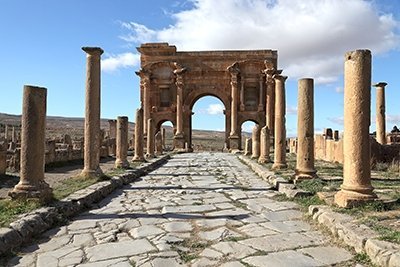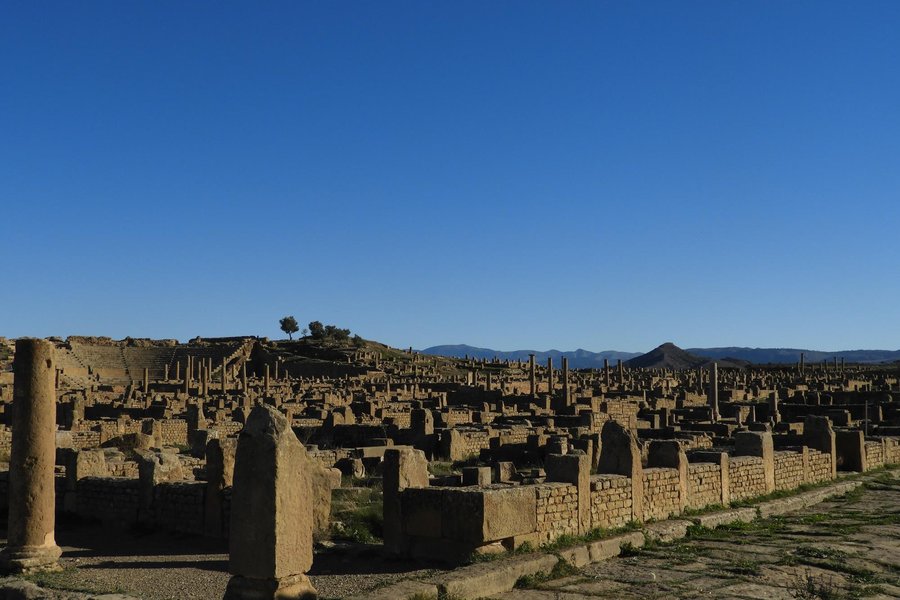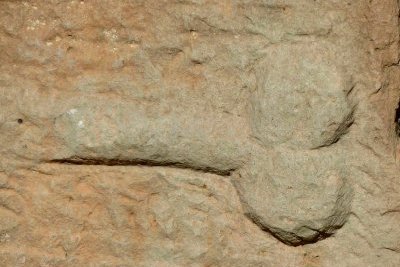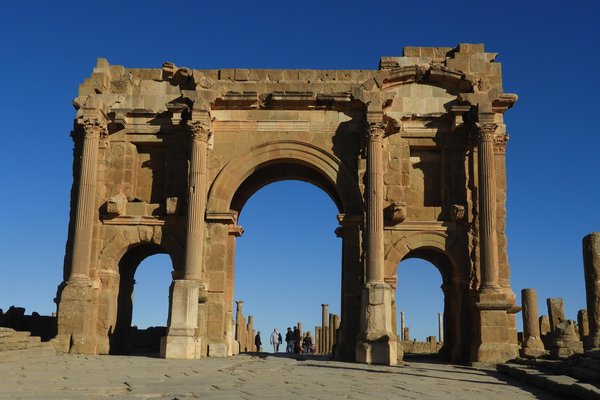Algeria
Timgad
Timgad is an example of Roman urban planning that extended from a military camp.
Timgad, called Thamugas by the Romans, was a Roman colony in North Africa founded by Emperor Trajan around 100 CE. Its typical grid plan included features such as paved streets, 14 baths and Trajan's Arch, a 12 m high triumphal arch.
Community Perspective: Solivagant explains how Timgad differs from other Roman ruins along the North African coast as it was built ‘ex nihilo’ as a Roman “ideal city”. Juha ranks its ruins “among the best outside of Italy”; he also provides information on how to get there.
Site Info
Official Information
- Full Name
- Timgad (ID: 194)
- Country
- Algeria
- Status
-
Inscribed 1982
Site history
History of Timgad
- 1982: Inscribed
- Inscribed
- Type
- Cultural
- Criteria
- ii
- iii
- iv
Links
- UNESCO
- whc.unesco.org
- Related
-
- arxiv.org — The orientation of Trajan's town of Timgad
- en.wikipedia.org — Timgad on Wikipedia
All Links
UNESCO.org
- whc.unesco.org — whc.unesco.org/
Related Resources
- arxiv.org — The orientation of Trajan's town of Timgad
- en.wikipedia.org — Timgad on Wikipedia
News Article
- Oct. 24, 2024 agenzianova.com — Restoration of the Roman site of Timgad, an archaeological treasure and tourist destination, begins
Community Information
- Community Category
- Archaeological site: Ancient Rome
Travel Information
Recent Connections
-
Perfect Inscriptions
1982 -
James Bruce
Travelling Northern Africa, British exp… -
Spolia
The Byzantine Reconquest revived some a…
Connections of Timgad
- Individual People
-
-
Emperor Trajan
Trajan's Arch -
James Bruce
Travelling Northern Africa, British explorer James Bruce reached the city ruins on 12 December 1765, likely being the first European to visit the site in centuries and described the city as "a small town, but full of elegant buildings." In 1790, he published the book Travels to Discover the Source of the Nile, where he described what he had found in Timgad. (wiki Timgad)
-
- Trivia
-
-
Dubbed as another WHS
Numidian (or Algerian) Pompeii
-
- History
-
-
Ancient Roman colonies
Timgad was created ex nihilo as a military colony by the Emperor Trajan in AD 100. (official description) -
Byzantine Empire and Civilization
In 535 CE, the Byzantine general Solomon found the city empty when he came to occupy it during the Vandalic War. In the following century, the city was briefly repopulated as a primarily Christian city before being sacked in the 7th century after the Muslim conquest of the region. (Wikipedia - Timgad)
-
- Architecture
-
-
Mosaic art
"The houses, of varying sizes, dazzle by their sumptuous mosaics, which were intended to offset the absence of precious marbles." UNESCO Web site -
Spolia
The Byzantine Reconquest revived some activities in the city, defended by a fortress built to the south, in 539, reusing blocks removed from Roman monuments. (Unesco website)
-
- Damaged
-
-
Destroyed during invasion
After the Vandal invasion of 430, Timgad was destroyed at the end of the 5th century by montagnards of the Aurès. The Byzantine Reconquest revived some activities in the city (...). The Arab invasion brought about the final ruin of Thamugadi which ceased to be inhabited after the 8th century. (Unesco website)
-
- World Heritage Process
-
-
Perfect Inscriptions
1982
-
- Human Activity
-
-
Historical Graffiti
A Latin inscription, with a typographical error, chiseled into the stone steps surrounding the Forum square reads: “To hunt, bathe, play [games or gambling?], to laugh. That is life!". -
Brothels
-
Festivals
Timgad International Festival of Music. Held from 1967 - 1986 and 1998 to present. Was originally held in Timgad's Roman Amphitheatre but UNESCO complained about damage to the structure and, since 2010, it has been held in a purpose built faux Roman amphitheatre just beyond the inscribed boundarySee fr.wikipedia.org
-
- Constructions
-
-
Latrines
-
Triumphal Arches
Trajan's Arch -
Baths
-
Theatres and Opera Houses
Roman theatre -
Macellum
Has 2 "Macella". The Sertius and the " Eastern". See
-
- Timeline
-
-
Built in the 2nd century
founded around 100
-
- Science and Technology
-
-
Libraries
Roman librarySee www.jstor.org
-
- Literature & Film
-
-
Featured in the Go Jetters
Series 2: Episode 31: Timgad Ruins, Algeria
-
News
- agenzianova.com 10/24/2024
- Restoration of the Roman site of T…
Recent Visitors
Visitors of Timgad
- AC
- Adrian Turtschi
- Alexander Barabanov
- A. Mehmet Haksever
- Artur Anuszewski
- Ask Gudmundsen
- Atila Ege
- Bill Maurmann
- Boj
- Bram de Bruin
- Dimitar Krastev
- edstar500
- Emili Xaus
- Eva Kisgyorgy
- George Gdanski
- Gernot
- Harry Mitsidis
- Iain Jackson
- Jon Opol
- Juha Sjoeblom
- Loic Pedras
- Luis Filipe Gaspar
- Maciej Gil
- Martin
- Michael Novins
- michaelsballard
- Mikko
- Milan Jirasek
- Miloš Tašković
- Nihal Ege
- Pincze
- pressdm
- Roman Bruehwiler
- Solivagant
- Szucs Tamas
- Thomas Buechler
- Thomas van der Walt
- Timothy C Easton
- Weecheng
- wendy007
- Wo_ko
- Zoë Sheng
Community Reviews
Show full reviews
Site visited December 2013. Timgad is the largest and arguably the best of the Roman archaeological sites of Algeria. I think it is also one of top three Roman sites of Africa and, I dare to say, probably among the best outside of Italy. Timgad is not known for its imposing buildings but for town planning and well preserved grid plan. In this review I focus mainly on the practical issues of visiting Timgad.
Algeria, especially the eastern part of the country, is one of the hotspots of Roman archaeological sites. Apart from the inscribed ones there are several sites worth mentioning: Tiddis, Madauros (Madaure), Hippo Regius (Hippone), Theveste, Thubursicum and Lambaesis. Many of these have been collected to a TWHS Sites, lieux et itineraires augustiniens du Maghreb central.
Timgad or Thamugadi is an ancient military colony founded in 100 AD by Trajan. It is a good example of Roman town planning. It is originally a city with a tight grid plan. Two main streets cardo and decumanus go through it. In the center of these two streets are spacious forum and a theatre. In the middle of 2nd century the city grew outside the original orthogonal design. Outside the grid plan are Capitol, several churches and baths, markets and some homes. A big Byzantine fortress 0,5 kilometres from the original city is the last built structure in Timgad.
Visiting Timgad feels like being long away from everything. It is a long …
Keep reading 0 comments
On the morning of April 16,1928, my mother and I were among the very few--and silent few as I recall-- standing among the melancholy ruins of Timgad.
I also visited the Bardo museum with its magnificent collection of mosaics. I believe it is now closed.
Keep reading 0 comments
With 3 of Algeria’s 7 sites being “Roman ruins” it is perhaps too easy to slide into the “just another ruined city” syndrome if Timgad isn’t your first. Yet each is different from the other and the value to be gained from visiting each comes from teasing out their differences rather than from identifying their similarities! Mind you – we visited 2 other non-UNESCO Roman sites, so we were reaching our limit!
Timgad’s “speciality” lies on the fact that it was built in 100 AD (at the behest of Trajan) “ex nihilo”, as UNESCO call it, i.e on empty land where no town/city had ever existed before and prospered greatly over the next 200 years in what seems to have been a cultured and peaceful existance. As such it represents a Roman “ideal city” as far as town planning was concerned – unconstrained by earlier layouts and also, given the relatively flat open site, by geographical limitations. Originally it was of a perfect grid pattern within a near square (though later developments went outside and didn’t entirely follow this). There are theories regarding the orientation of Roman grid towns based on astronomic calculations regarding sunrise on the day of foundation or on the birthday of the founder (Romans had “founding ceremonies” based apparently on earlier Etruscan and possibly Greek ones). This may explain why the main road out of Timgad to/from the nearby Military camp of Lambaesis, sets off at a definite angle to the main axes rather …
Keep reading 0 comments
I visited Timgad in the summer of 1975, it was more remarkable because I was not expecting this visage in the desert. I had been working in Algeria, and travelled extensively in the littoral country knowing it very well. I had a had visited Tunisia to renew my visa and on a whim decided to take a round about route Constantine to Biskra and Bou Saada and back to Blida. It was the end of a hot summers North african day when Timgad came into sight. I was spell bound and absolutely awestruck by the ruins shimmering in the saturant setting sun. To such an extent that nearly 30 years later I am still awestruck.
Keep reading 0 comments
